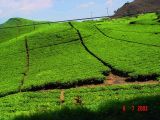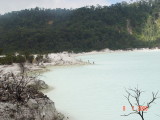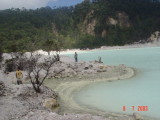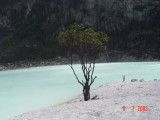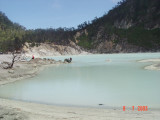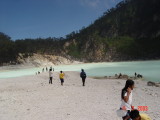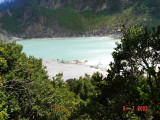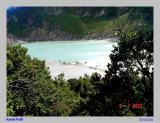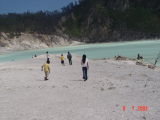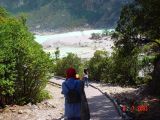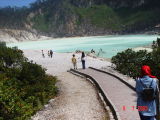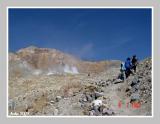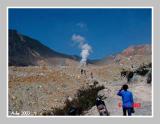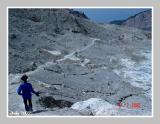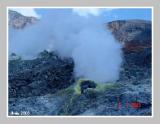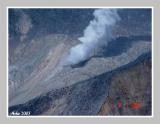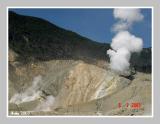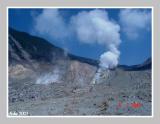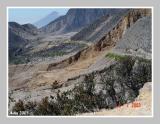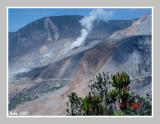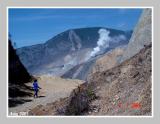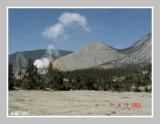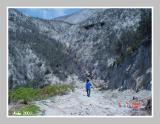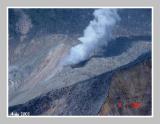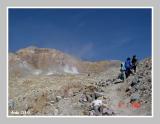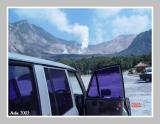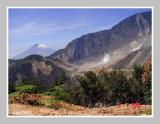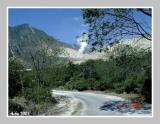- Voucher Hotel reservation
- Package Tour
- Daily Tour
- Rent Transportation A/C
Minggu, 29 Juni 2008
Primalaho Package Tour Statement
1. ONE DAY TRIP TO SOUTH EAST OF BANDUNG (GARUT)
- Kamojang Crater
- Papandayan Volcano
- Cipanas Hotspring
- Extra Ricefields
2. ONE DAY TRIP TO SOUTH OF BANDUNG (CIWIDEY)
- The Biggest Tea Plantations in Indonesia
- Patenggang Lake
- White Crater
- Extra Rice Fields & Strawberry Gardens
3. ONE DAY TRIP TO NORTH SIDE OF BANDUNG
- Tangkuban Perahu Crater
- Tea Plantations
- Ciater Hotsprings
- Extra Rice fields & Flower Market
- Udjo's Angklung School Performance *
4. ONE DAY TRIP BANDUNG ~ PANGANDARAN BEACH
- Papandayan Volcano
- Cipanas Hotsprings
- Kampung Naga (Traditional Tribe)
- Pangandaran Beach
- Extra a Beautiful Panorama Terrace Rice Fields
** All rate above are include Car, Driver, Fuel, Guide fee, Ticket Entrance & Parking en route **
5. LONG TRIPS BANDUNG ~ JOGJAKARTA (7 DAYS)
DAY 1: BANDUNG ~ CIWIDEY
- The Biggest Tea Plantations in Indonesia
- Patenggang Lake
- White Crater
- Extra Rice Fields & Strawberry Gardens
- Overnight in Bandung
- Kamojang Crater
- Papandayan Volcano
- Cipanas Hotspring
- Extra a Beautiful Panorama Terrace Ricefields
- Overnight in Cipanas
- Kampung Naga (Traditional Tribe)
- Pangandaran Beach
- Extra a beautiful Panorama Terrace Rice fields
- Overnight in Pangandaran
- Brown Sugar Processing
- Wooden Puppet
- Green Canyon
- Batukaras Beach
- Nature Reserve
- Overnight
- Seven Hot Waterfall
- Overnight in Baturaden Hill
- Borobudur Temple
- Mendut Temple
- Dinner & Witness Ramayana Ballet Performance
- Overnight in Jogjakarta
- Sultan Palace (Keraton)
- Sultan Water Castle
- Birds Market
- Batik & Silver Processing
- Overnight. FINISH
6. LONG DAY TRIP BANDUNG ~ KETAPANG HARBOUR
DAY 1: BANDUNG ~ CIWIDEY
- The Biggest Tea Plantations in Indonesia
- Patenggang Lake
- White Crater
- Extra Rice Fields & Strawberry Gardens
- Overnight in Bandung
- Kamojang Crater
- Papandayan Volcano
- Cipanas Hotspring
- Extra a Beautiful Panorama Terrace Ricefields
- Overnight in Cipanas
- Kampung Naga (Traditional Tribe)
- Pangandaran Beach
- Extra a beautiful Panorama Terrace Rice fields
- Overnight in Pangandaran
- Brown Sugar Processing
- Wooden Puppet
- Green Canyon
- Batukaras Beach
- Nature Reserve
- Overnight
- Seven Hot Waterfall
- Overnight in Baturaden Hill
- Borobudur Temple
- Mendut Temple
- Dinner & Witness Ramayana Ballet Performance
- Overnight in Jogjakarta
- Sultan Palace (Keraton)
- Sultan Water Castle
- Birds Market
- Batik & Silver Processing
- Overnight.
- Prambanan Temple
- Solo Palace (Keraton Solo)
- Ceto & Sukuh Temple
- Sarangan Lake
- Overnigh in Sarangan
- Full day Trip from Sarangan to Bromo & overnight in Bromo
- Vew Bromo Panorama Sunrise
- Full day Trip Bromo to Sempol & overnigt in Sempol
- Climb up & View Ijen Crater
- Ketapang Harbour. FINISH
7. LONG TRIP JAKARTA ~ KETAPANG HARBOUR (11 DAYS)
DAY 1: JAKARTA ~ ARRIVAL
- Meeting at Jakarta International Airport
- Jakarta City Tour
- Overnight
- Botanical Garden (Bogor)
- Puncak Pass & direct to Bandung
- Overnight in Bandung
- The Biggest Tea Plantation in Indonesia
- Patenggang Lake
- White Crater
- Extra Rice Fields & Strawberry Gardens
- Overnight in Bandung
- Kamojang Crater
- Papandayan Volcano
- Cipanas Hotspring
- Extra a Beautiful Panorama Terrace Ricefields
- Overnight in Cipanas
- Kampung Naga (Traditional Tribe)
- Pangandaran Beach
- Extra a beautiful Panorama Terrace Rice fields
- Overnight in Pangandaran
- Brown Sugar Processing
- Wooden Puppet
- Green Canyon
- Batukaras Beach
- Nature Reserve
- Overnight
- Seven Hot Waterfall
- Overnight in Baturaden Hill
- Borobudur Temple
- Mendut Temple
- Dinner & Witness Ramayana Ballet Performance
- Overnight in Jogjakarta
- Sultan Palace (Keraton)
- Sultan Water Castle
- Birds Market
- Batik & Silver Processing
- Overnight.
- Prambanan Temple
- Solo Palace (Keraton Solo)
- Ceto & Sukuh Temple
- Sarangan Lake
- Overnigh in Sarangan
- Full day Trip from Sarangan to Bromo & overnight in Bromo
- Vew Bromo Panorama Sunrise
- Full day Trip Bromo to Sempol & overnigt in Sempol
- Climb up & View Ijen Crater
- Ketapang Harbour. FINISH
8. MALAYSIA PACKAGES.
JAKARTA ~ BANDUNG
Meeting at Jakarta airport and depart to Bandung via visit Taman Safari & Puncak Pass then proceed directly to Bandung for check in at your book hotel.
BANDUNG EXCRUSION
Visit to North sight & South sight of Bandung.
- North Sight of Bandung: Tankuban Perahu, Ciater Hotsprings, Flower Market, Shopping,etc
- South Sight of Bandung: Strawberry Gardens, The Biggest Tea Plantations in Indonesia, Tasik Patenggang, White Crater, Shopping, etc.
- Full day trip to explore Bandung shopping centre as long the main roads in Bandung
- Check out from hotel; to drop out Airport. FINISH
Email address: primalaho@rocketmail.com / don_kemon@yahoo.com
Contact Person: Dhani Setiawan
Mobile: +628157007630
Malaysian Package
JAKARTA ~ BANDUNG
BANDUNG EXCURSION
Visit to North sight & South sight of Bandung.
- North Sight of Bandung: Tankuban Perahu, Ciater Hotsprings, Flower Market, Shopping,etc
- South Sight of Bandung: Strawberry Gardens, The Biggest Tea Plantations in Indonesia, Tasik Patenggang, White Crater, Shopping, etc.
- Full day trip to explore Bandung shopping centre as long the main roads in Bandung
- Check out from hotel; to drop out Airport. FINISH
If You have any itenary program for your ownself trip, please give us then please let we organize your trip. Be Leisure & Pleasure.
Email address: primalaho@rocketmail.com / don_kemon@yahoo.com
Contact Person: Dhani Setiawan
Mobile: +628157007630
INDONESIA
GEOGRAPHY
The Republic of Indonesia comprises the world's largest archipelago, spanning 3,200 miles from east to west along the Equator-roughly equivalent to the expanse of United State from coast to coast-and 1,100 miles from north to south. Indonesia's 13,667 islands are nestled between two continents, Asia and Australia, and two oceans, the Indian and the Pacific.
Main Islands: Java, Sumatra, Sulawesi, Bali, Kalimantan, Nusa Tenggara, Maluku, and Irian Jaya (the western part of New Guinea).
Area: Indonesia's land are totals 782,665 square-miles and its sea territory 1,222,466 square-miles. Indonesia shares land border with Malaysia, Brunei Darusalam and Papua New Guinea and sea border with Singapore, Thailand, Vietnam, the Philippines and Australia.
Major Cities: Jakarta (the capital; 1990 Census population: 8.2 million), Surabaya (2.5 million), Bandung (2.0 million), Medan (1.7 million), Semarang (1.2 million).
Climate: Equatorial, but cooler in the highlands. Temperatures generally range from 68 to 89 degrees. Humidity ranges from 60 to 90 percent. Indonesia's "wet season" lasts from November through April and its "dry season" from May through October, with slight variations in its regional sub-climatic zones.
PEOPLE
Population: With 179 million inhabitants in 1990, Indonesia is ranked the world's fourth most populous nation after China, India and Pakistan.
Annual Growth Rate: 1.97 percent from 1980 to 1990.
Language and Ethnicity: While largely of Malay stock, the inhabitants of the Indonesia archipelago constitute a rich array of some 300 distinct cultures, each with its own individual language or dialect. Virtually all Indonesians are united by a common national language, Bahasa Indonesia.
Religion: A full 85 percent of Indonesians subscribe to the Islamic faith, ten percent to Christianity, two percent to Hinduism, and three percent to either Buddhism or animism.
Education: Ninety percent of Indonesians attend primary schools, and 86.3 percent are literate. There are 49 state universities and over 200 private universities.
Tourist in Indonesia
Tourism in Indonesia is an important component of the Indonesian economy and an important source of foreign exchange revenues. With a vast archipelago of more than 17,000 islands,[1] the second longest shoreline in the world,[2] 300 different ethnic groups and 250 distinct languages,[3] and tropical climate throughout the year, nature and culture are two major components of Indonesian tourism.
Tourism in Indonesia is currently overseen by the Ministry of Culture and Tourism. International tourist campaigns have been focusing largely on tropical destination with white sand beaches and blue sky imageries. Beach resorts and hotels were developed in some Indonesia islands, with Bali island as the primary destination. Cultural tourism is also an important part of Indonesia tourism industry. Toraja, Prambanan and BorobudurYogyakarta and Minangkabau are popular destinations for cultural tourism, apart from many Hindu festivities in Bali. About 5 million foreign tourists have visited Indonesia annually since 2000.[4] temples,
However, tourism development had sometimes clashed with local people, that has created criticism over Indonesia's tourism industry. Most of the disputes were related over land possession, local traditions (adat) and the impact of tourism development to the local people. In another area, tourism industry in Indonesia faces major threats. Since 2002, several warnings have been issued by some countries over terrorist threats and ethnic/religious conflicts in some areas, which significantly reduces the number of foreign visitors.
Jakarta
Jakarta, the capital city of the Republic of Indonesia, is a special territory enjoying the status of a province, consisting of Greater Jakarta, covering an area of 637.44 square km. Located on the northern coast of West Java, it is the center of government, commerce and industry and as such has an extensive communications network with the rest of the country and the outside world. As Indonesia's main gateway, the Soekarno-Hatta International Airport serves a growing number of international airlines and domestic flights. Jakarta is a city of contrasts; the traditional and the modern, the rich and the poor, the sacral and the worldly, often stand side by side in this bustling metropolis. Even its population, gathered from all those diverse ethnic and cultural groups which compose Indonesia, are constantly juxtaposed as an ever- present reminder of the national motto; Unity in Diversity.
Finding its origin in the small early 16th century harbor town of Sunda Kelapa, Jakarta's founding is thought to have taken place on June 22, 1527, when it was re-named Jayakarta, meaning
Glorious Victory by the conquering Prince Fatahillah from neighboring Cirebon. The Dutch East Indies Company which captured the town and destroyed it in 1619, changed its name into Batavia and made it the center for the expansion of their power in the East Indies. Shortly after the outbreak of World War II, Batavia fell into the hands of the invading Japanese forces who changed the name of the city into Jakarta as a gesture aimed at winning the sympathy of the Indonesians.
The name was retained after Indonesia achieved national independence after the war's end.
The ethnic Jakartan called "Orang Betawi" speaks Betawi Malay, spoken as well in the surrounding towns such as Bekasi and Tangerang. This language has two variations: the conventional Betawi Malay and the modern Jakarta Malay. While the first is spoken by the elder people, born and bred in Jakarta, the second is spoken by the younger generation and migrants.
Jakarta's architecture reflects to a large extent the influx of outside influences which came and has remained in this vital seaport city. The Taman Fatahillah Restoration Project, begun in the early 1970s has restored one of the oldest sections of Jakarta also known as Old Batavia to approximately its original state.
The old Portuguese Church and warehouse have been rehabilitated into living museums. The old Supreme Court building is now a museum of fine arts which also houses part of the excellent Chinese porcelain collection of former Vice President Adam Malik. The old Town Hall has become the Jakarta Museum, displaying such rare items as Indonesia's old historical documents and Dutch period furniture.
Its tower clock was once returned to England to be repaired under its lifetime guarantee, which up to now has already lasted hundreds of years.
One of the most interesting tourist attractions is the "Beautiful Indonesia in Miniature Park" popularly called "Taman Mini". Built to portray the variety of cultures found within the many islands contained in the Republic of Indonesia, this open-air museum comprises the many architectural forms of arts and traditions of all 27 provinces. It is proof of the country's motto of Unity in Diversity as well as Freedom of Religion depicted in the houses of worship built on the grounds.
Jakarta has preserved its past and is developing for the future. Skyscrapers in the center of the city are part of a new look.
Modern luxury hotels today cater to the discriminating visitors. Transport within the city is plentiful. It should be noted that museums are open daily from 8.00 a.m. (except Mondays) till 2.00 p.m. on Tuesdays, Wednesdays, Thursdays and Sundays. On Fridays closing hour is 11.00 a.m. and on Saturdays at 1.00 p.m.
PLACES OF INTEREST
The National Monument
The National Monument, or "Monas" as it is popularly called, is one of the monuments built during the Sukarno era of fierce nationalism. It stands for the people's determination to achieve freedom and the crowning of their efforts in the Proclamation of Independence in August 1945. The 137-meter tall marble obelisk is topped with a flame coated with 35 kg. of gold. The base houses a historical museum and a hall for meditations. The monument is open to the public and upon request the lift can carry visitors to the top which offers a bird's eye view on the city and the sea.
Central Museum
Established in 1778 by U.M.C. Rademacher under the auspices of the Batavia Association of Arts and Sciences, it offers historical, prehistorical, archaeological and ethnographic aspects of Indonesia through its extensive collection of artifacts and relics which date as far back as to the Stone Age. It has one of the most complete collections of bronzes and ceramics dating back to the Han, Tang and Ming Dynasties. The Museum has one of the finest numismatic collections in the world, including cloth and money which was used on several islands until recently. The religious art section is filled with statuary and sculpture salvaged from sites of Hindu, Buddhist and Islamic edifices. Its collection of cultural instruments, household utensils, arts and crafts provide an introduction to the life of the various ethnic groups which populate Indonesia. This museum is popularly known as Gedung Gajah or "Elephant Building" because of the stone elephant offered by King Chulalongkorn of Thailand in 187 1, placed on the front lawn of the building.
Indonesia in Miniature Park
An extensive park to get a glimpse of the diverseness of the Indonesian archipelago, it represents Indonesia's 27 provinces and their outstanding characteristics, reflected most strikingly in the exact regional architecture of the province. It has its own orchid garden in which hundreds of Indonesian orchid varieties are grown. There is also a bird park with a walk-in aviary, a fauna museum and recreational grounds with a swimming pool and restaurants.
Of special interest here at Taman Mini is the Museum Indonesia. A richly decorated building in Balinese architecture, it houses contemporary arts, crafts and traditional costumes from the different regions of the country.
Open from 9.00 a.m. to 4.00 p.m. daily.
"Theater Imax Keong Emas" (Golden Snail Theater)
Located in the Taman Mini is the Imax theater which presents "Beautiful Indonesia" on a gigantic screen using the latest Imax system.
Open from 11.00 am - 5.00 pm.
This is Jakarta's largest and most popular recreation park. It is built on reclaimed beach land at the Bay of Jakarta, having, sea and freshwater aquariums, swimming pools, an artificial lagoon for fishing, boating, bowling, an assortment of nightclubs, restaurants, a steam-bath and massage parlors.
Daily shows are held at the Aquarium where dolphins and sea lions perform. The Ancol complex includes a Marina, Dunia Fantasi (Fantasy Land), a golf course, hotels and a drive-in theater. The "Pasar Seni" or art market has a varied collection of Indonesian handicraft, paintings and souvenirs on sale.
At a nearby open-air theater art performances are held using the local dialect.
Fantasy Land
A recent addition to Jakarta's growing recreation facilities is the Fantasy Land, a 9.5 hectares (23.75 acres) entertainment park located inside the Ancol Dreamland. Planned to eventually become a part of a 200-hectares (500-acres) park designed to usher the visitors into the fascinating world of modern science and technology, the present facility takes them on an imaginative tour of Old Jakarta, Africa, America, Indonesia, Europe, Asia and the Palace of Dolls. Each of the areas is designed to give the visitor a feel of the region he is visiting through features and architecture of the area at a certain period of its history and by the use of animated puppets in the Palace of Dolls.
The park also offers a number of restaurants and souvenir shops.
The Marina Jaya Ancol
This is a special port for yachts, motor and sail boats, the port of departure for Pulau Seribu and the scattered islands in the Bay of Jakarta. This is also the place for marine recreation and sports where each facility is amply provided; water cycles, canoes, sail boats, fishing gear and many others. Stalls along the beach serve drinks and snacks while tents are available for sunbathers and sea lovers.
Jakarta Museum
Completed in 1627, the building initially served as the Dutch East Indies Company's Town Hall. Additions and renovations including a stone gate, offices and renovations were added between 1705 and 1715. The known Indonesian hero, Diponegoro, was said to have been imprisoned in its dungeon before his exile to South Sulawesi.
The building was used as military barracks and offices when the Jakarta City Administration decided in the early 1970s to make it the focus of a restoration plan of old Batavia. Now a museum, it provides the historical background of Jakarta through displays of old maps and antiquities including furniture and porcelain used by the Dutch rulers of Batavia, plus a 16th century Portuguese cannon which stand across the cobblestone square.
Sunda Kelapa
Sunda Kelapa, better known as Pasar Ikan (meaning fish market) is located at the mouth of the Ciliwung river. It was formerly the harbor town of Sunda Kelapa where the Portuguese traded with the Hindu Kingdom of Pajajaran in the early 16th century.
The fish catch of the day was auctioned in the early morning at the old fish market. The street leading to it was lined with shops selling all sorts of shells, dehydrated turtles, lobsters and mostly everything the seafarer might need.
Dutch domination of Jakarta and the rest of Indonesia began from this area, whereas the remnants of Kasteel Batavia, an old fort and trading post of the Dutch East Indies Company can still be seen now. Sunda Kelapa is at present a fisherman's wharf and an interisland port. Tall masted Bugis schooners from South Sulawesi anchoring there offer a picturesque scene. They belong to one of the last-fleets of sail boats in the world and still ply the seas between the islands, as they did centuries ago, carrying merchandise.
Bandung
| Introduction | ||||||||||||||||
City of Flowers and Paris of Java (as it was known in the colonial times), Bandung has still maintained its European ambience and sophistication. Situated at a distance of just 175 km. off Jakarta, Bandung is the provincial capital of West Java and third largest city of Indonesia. The outgoing nature and strong belief in their culture of local Sundanese people makes it quite a change from the other cities in the country. Bandung is known more as the place which hosted the first Afro-Asian Conference in 1955 then anything else and it is a pity. It has a pleasant climate and plenty of natural escapes that gives the tourists a break from the hectic schedule they might have anywhere else in the country. The city is also a centre of higher education with Bandung Institute of Technology being one of the most important destination of students in Asia-Pacific. | ||||||||||||||||
| What to do | ||||||||||||||||
Bandung is surrounded by a mountainous region full of cool breeze and natural splendours. A visit to these places should be a must on every tourist's itinerary. Shopping in Bandung is quite an affair and their are many markets around the city to fulfill your shopping needs. Bandung is one of the best place in entire Indonesia to have inexpensive but quality food. Make sure that you have not missed on getting experience of the city life that goes on in Bandung before leaving. | ||||||||||||||||
| City at a Glance | ||||||||||||||||
| ||||||||||||||||
| History | ||||||||||||||||
Though the existence of the city is very old as archeological finds suggest, the first reference to the city dates back to AD 1488 only. Europeans first reached this region in the 18th century and by the end of this century, they had constructed a road that connected Jakarta, Bogor, Cianjur, and Bandung. The city continued to grow in the subsequent decades and by 1880, first rail line between Jakarta and Bandung was completed. The city got tremendous boost due to plantations of tea, quinine, and coffee that were introduced to the highlands around the city. City became a municipality in 1906 and it started expanding from this time. Bandung played an important role in the freedom movement of Indonesia. In 1946, after the end of Second World War when colonial powers were returning to claim their earlier colony, the residents of Bandung burnt down their town and fled away. Today, Bandung is a prosperous and thriving city and it has a vibrant youth culture because of a number of educational institutes that it posses. | ||||||||||||||||
Weather and Best Season to Visit | ||||||||||||||||
There is not much seasonal variations in Bandung and the time of visit here is determined by the extent of rain. Day and night temperature vary considerably. While the day temperature remains in the range of 26ºC to 33ºC, night temperature can drop to a low of 10ºC. Two seasons are clearly defined, east monsoon from June to September that brings the dry climate while West Monsoon from December to March that brings heavy rain. High humidity is an year round phenomenon in Bandung. June to September being the dry season is certainly preferred over rainy season. | ||||||||||||||||
| Attractions | ||||||||||||||||
| Gedung Papak | ||||||||||||||||
Built in the year 1920, this building was used as the City Hall in its initial years and later as the office of Bandung Municipality. The structure has been artistically restored recently and now becoming a good tourist attraction. | ||||||||||||||||
| Bumi Silwangi | ||||||||||||||||
The building was constructed in 1825 by a Eurasian millionaire of Italian origin, D. W Berrety. This building is a perfect point from where you can see the beauty of Bandung. It is now being used as Bandung Institute of Teachers Training Education. | ||||||||||||||||
| Bandung Insitute of Technology | ||||||||||||||||
This is the most important and one of the oldest centre of higher education in Indonesia. The institute has provided the country many of its leading personalities such as Soukarno and B. J. Habibie. The building has been constructed artistically that gives it a uniqueness from other institutions. | ||||||||||||||||
Places Nearby | ||||||||||||||||
| Ciater Hot Spring | ||||||||||||||||
The hot spring located at the base of Mount Tangkuban Perahu is a favourite picnic spot for the residents of Bandung. The site is situated at a distance of just 32 km north of Bandung and easily accesible by road. | ||||||||||||||||
Maribaya | ||||||||||||||||
Drive along the Bandung - Lembang - Maribaya route for around 90 minutes passing through flowery mountainous landscape and you would find yourself in Maribaya. The place is famous for its beautiful agro landscape, hot water springs, and waterfall. | ||||||||||||||||
Tangkuban Perahu (Capsized Boat) | ||||||||||||||||
Situated at a distance of around 28 km north of Bandung, this is a 2000 metre wide volcano. The route to Tangkuban Perahu is a mesmerising introduction to Bandung landscape. Crater can be approached by the bus only while you may have to walk on to reach the Geological Station on the upper rim of the crater. On an active crater you can also see the boiling water jetting out of the ground. | ||||||||||||||||
Kawah Putih / White crater | ||||||||||||||||
These craters are situated at Ciwidey, some 40 km south of Bandung. The craters have been now filled with sulphuric water giving them different hue and colours. Sometime it looks that the craters have been covered by the ice sometime they change colour from blue to green. Quite an experience. Papandayan Volcano Papandayan is a complex stratovolcano with four large summit craters, the youngest of which was breached to the NE by collapse during a brief eruption in 1772 and contains active fumarole fields. The broad 1.1-km-wide, flat-floored Alun-Alun crater truncates the summit of Papandayan, and Gunung Puntang to the north gives the volcano a twin-peaked appearance. Several episodes of collapse have given the volcano an irregular profile and produced debris avalanches that have impacted lowland areas beyond the volcano. A sulfur-encrusted fumarole field occupies historically active Kawah Mas ("Golden Crater"). After its first historical eruption in 1772, in which collapse of the NE flank produced a catastrophic debris avalanche that destroyed 40 villages and killed nearly 3000 persons, only small phreatic eruptions had occurred prior to an explosive eruption that began in November 2002. | ||||||||||||||||
Important Festivals and Exhibitions | ||||||||||||||||
Sundanese people are known for their outgoing attitude and strong belief in their culture. Bandung is a good place to watch cultural performances that are held round the year at major convention centres in the city. | ||||||||||||||||
Shopping | ||||||||||||||||
The shopping in Bandung is an enduring experience full of fun. As the city is capital to Western Java, you can look for traditional as well as imported goods in the market. Pasar Kota Kembang is the best place to shop for cheap clothes and leather products. Kampung Ciguriang is the first market in the city while Pasar Baru, Jl. Pasar Utara, Jalan Pasar Selatan, Pasar Jatayu are some of the good places to look for local products. | ||||||||||||||||
| Where to Stay | ||||||||||||||||
If you have some money to blow then ask for some of the newly restored heritage hotels in the city. They are the best introduction to the past of the city and the future that lies ahead. Most of the accommodation options are inexpensive but the services are certainly good. | ||||||||||||||||
| Where to Eat | ||||||||||||||||
Bandung is the virtual heaven for taste buds. Whether it is traditional Bandung cuisine or international one, you would not find any scarcity in any corner of the city. Jalan Diponegoro, Jalan Merdeka, and Alun - alun are some of the best places to hunt for inexpensive local varieties. Food is tasty everywhere and should give you some new experiences in dining. | ||||||||||||||||
| Travel Information | ||||||||||||||||
| Air Travel Resources | ||||||||||||||||
The city of Bandung is connected to Indonesian capital Jakarta and some other places in Java by air. The airlines that connected Bandung with other cities are Merpati Nusantara Airlines and Bouraq. Husein Sastranegara Domestic Airlines is situated just outside the city limit |
Bandung Bandung Cihampelas street Bandung Cibaduyut street
Getting There
The streets of Dago are easy to locate. From the
Where to Stay
Plenty of lodgings are available in this city. From youth hostels to five-starred hotels, choose the one that is suitable for you.
Moving Around
Dining Guide
See Bandung's Dining Guide for details.
Souvenir Tips
Other Things to See or Do
Travel Tips
Not all stores accept credit cards, so make sure you have sample amount of cash ready.
Try every item before you buy it, if possible.
Drink and eat before you shop. Shopping with an empty stomach is indeed and unpleasant experience.
More : Bandung Hotels
Allen
Jl. LMU Nurtanio No. 79-83
Au'let
Jl. Ir.H Juanda No. 141
Azalia
Jl. Naripan No. 62 E
Azka Fashion
Jl. Kiaracondong No. 182
B n' C Casual
Jl. Merdeka No. 25-27
B.O.S
Jl. Otten One No. 6
Ba-joe
Jl. Sultan Tirtayasa No. 15
Jl. Sumatera No. 24
Jl. Soekarno Hatta No. 397
Best Choice
Jl. Setiabudi No. 158
Blossom
Jl. Juanda
Blossom
Jl. Sriwijaya
Cargo
Jl. Diponegoro No. 30
Carvieno Collection
Jl. Kepatihan No. 11,
King Shopping Centre Lt.1 BOX NKLI
Carvieno Collection
Jl. Soka No. 1
CAT 17
Jl. Prof. Eyckman No. 17
Jl. Sukajadi
Cisangkuy Factory Outlet
Jl. Cisangkuy No. 58
Dago Stock Ekspor
Jl. Ir.H Juanda No. 52
DNA
Jl. Brabtas No. 27
Eiffel Fasion
Jl. Malabar No. 59
Emporio
Jl. Ir. Sutami No. 109
Expose
Jl. Cipaganti No. 60
FOS
Jl. Setiabudi No. 56
Fosh Fashion
Jl. Soekarno Hatta No. 235
Funky Outlet Store
Jl. Dr. Otten No. 12
Grha Mode
Jl, Sukajadi 186
Gscuz
Jl. Gatot subroto No. 131
Heritage
Jl R.E Martadinata No. 63
Joy Fashion
Jl. Kebon Jati No. 208
Knock Clothing
Jl. Banda No. 3s
Kosmo
Jl. BKR 113 Lingkar Selatan
Labana Collection
Jl. Buah Batu No. 270
M&M
Jl. Ir. H Juanda No. 81-83
M.O.S
Jl. Eyckman No. 12B
Metropolis
Jl. Riau No. 55
Misyelle
Jl. Sukajadi No. 158
MMM
Jl. Karawitan No. 44
Mooi
Jl. Cemara No. 83
Naripan Stok Ekspor
Jl. Naripan No. 110
Nen'z Fashion
Jl. Sunda No. 55
No Label shop
Jl. Bengawan No. 53
No Label shop
Jl. Otten No. 1
Otten
Jl. Dr. Otten No.
Pipperoo
Jl. Pajajaran No. 62
Pipperoo
Jl. Otten No. 1
Pipperoo
Jl. Cihampelas,
Putri Dago
Jl. Ir.H.Juanda No. 18
Quota
Jl. Sulanjana No. 14
Raflesia
Jl. Djuanda
Rainbow
Jl. Sukajadi No. 168-170
Ralbi & Renaldi
Jl. Kebon Kaung No. 54
Renarrity
Jl. R.E Martadinata No. 26
Riau Stock Mall
Jl. LLRE Martadinata No. 160
Rich and Famous
Jl. Ir. H Juanda No. 14
Rumah Mode
Jl. Setiabudi No. 14 F
Shafira House
Jl. LL. RE. Martadinata No. 25
SOO
Jl. Sukajadi No. 198 B
Stock Centre
Jl. Soekarno Hatta No. 24
Stock Corner
Jl. Pelajar Pejuang 45 No. 60
Stocktown Griya Toserba
Jl. Buah Batu No/ 178
Stop N Shop
Jl. Ir. H Juanda No.152
Terminal Mode
Jl. Lombok No. 45
The Big Price Cut
Jl. Aceh No. 66 - Graha Mandala Siliwangi
The Sumit
Jl R.E Martadinata No. 61
Totally 4 U
Jl. Sukajadi No. 228 A
Unique
Jl. Otten No. 11
Up Town
Jl. Ir. H Juanda No. 84
Versaci
Jl. Setiabudhi
Viersa
Jl. Soka No. 3
VIP
Jl. Ir. H. Juanda No. 24
X Pose
Jl. Cipaganti No. 60 A
XO 2000
Jl. Sukajadi No. 212
DISTRO (Distribution Outlet)
Distros have become a phenomena in
Clothes may maketh the man, but after glancing down
The mushrooming of distro, or independent fashion outlets, throughout Indonesian metropolitan centres shows that sometimes the best people to satisfy the youth market are young people themselves. But have the original reasons for distro been lost to capitalism and competition?
Collectivism and creativity
Distro is a shortening of the Indonesian word distribusi, or distribution. Generally distro differ from other youth fashion outlets by their links to the independent music industry, the age of those involved, and collective ownership styles.
In 1993, a few die-hard music fans set up a music studio in
Distro provide a vehicle for creative collective members to market and disseminate their talents. Promoting artistic licence over profit margins, distro do not source stock from factories. Instead most have their own in-house labels with all goods made in small runs. Originality and scarcity are selling points.
Cooperation marked the birth of distro, and to a certain extent it is still evident today. Lined up alongside the distro’s own merchandise are products made by friends also in the clothing game. Staffing is usually a collegiate arrangement with members working in shifts to keep overheads down. Profits are split in proportion to capital investment in the store.
Distro size and scale is as varied as the size and shape of the wallets behind them. One of the first distro I went to was Bandit. A punk hangout, Bandit was just a glass cabinet covered by a tarpaulin with two rickety benches, right next to a McDonald’s garbage skip. These days most are housed in converted garages or small shop fronts.
Distro are a contrast to
Underground beginnings
Distro originally developed from the do-it-yourself ethic of the underground music community. However, they soon evolved into a forum for exchanging news about developments in the music scene.
In the early nineties, before the internet was easily accessible, dedicated fans could only gain information from overseas through mail order. As a result, underground music news had very limited circulation. I remember the frustration when a much-awaited newsletter would be sent wayward in
In this embryonic stage, political aspirations were rarely expressed overtly. The repressive nature of Suharto’s New Order government meant that rebellious, anti-establishment political views were best whispered, rather than yelled.
Amid the popular discontent of 1997, however, the group behind Riotic Distro broadened discussion to include politics. Riotic was the first
At the peak of the radical punk movement in
Going mainstream
In 2003, however, distro underwent a rapid shift. One of
The crew behind 347 were from upper middle-class families and had more capital at their disposal than most of their forerunners. This capital, and a clever combination of marketing, attractive packaging, high quality design, good fabrics and screen printing, was 347’s strength. Very quickly its products matched those of international street and surf wear brands, although without the prohibitive price tag.
Taking millions of rupiah a day, the store soon became well-known throughout
This success means that distro are no longer hidden from mainstream view. Where once they were a place for underground music sub-cultures and the politically disenfranchised to share ideas away from the scrutiny of society, they now vie for strategic space close to city centres, shopping malls, high schools, and universities. It is not uncommon for a distro to be a popular after-school hangout.
In
Music
Distro über cool is not limited to clothing. What’s ‘in’ is broad in definition and covers everything from clothes and accessories to cassettes, CDs and posters. Any respectable distro offers a selection of all of the above, but with affordable prices that mock the efforts of their large-scale competitors.
Continuing links to the underground music scene mean that these days many of the larger distro have a department that produces music. This scenario provides a means for independent bands to release music, while at the same time avoid the drawbacks of the commercially-orientated recording industry. In an elegant symbiosis, the resulting album is then sold through the distro networks. Key indie labels that have grown from distro include Riotic Records (from Riotic distro) and Flatspils (from 347 distro).
This cooperation can also extend to band merchandise. Bands will request distro to design and sell band t-shirts. In return, band members will wear distro-designed t-shirts during gigs.
Commercial orientation
Yet the increased popularity of distro has resulted in a shift in the orientation of many distro from an ideological one to commercial one. In recent times, entrepreneurially-minded individuals have also set up distro as profit-making enterprises rather than creative collectives. Distro now market their t-shirts, wallets and backpacks to the fashion-conscious. They have also lost the political potency that characterised early distro. Instead of facilitating revolutionary meetings, distro are more likely to use their strategic placement to host Saturday night street-side gatherings.
With increased competition, less flexible and imaginative distro failed. The survivors are more commercially savvy and have learnt the importance of self-promotion. Distro now hand out free items such as stickers, badges, and posters at concerts and gigs. At a recent hip-hop gig in one of
Many distro also advertise in the larger, more widely distributed glossy independent print media publications such as Ripple Mag, Suave, and D!!Side. Some of the larger distro are even sponsoring timeslots on local radio, holding quizzes and hosting local indie bands.
Some elements of the original collective ideology of distro remain, such as information sharing and fostering local music. Many websites are devoted to information and tips on setting up a distro or fashion label. Distro-run forums and blogs (web-based diaries) are used for networking and advertising other distro and labels. Forum members can also post information about gigs and events that their store has organised.
Costs of success
From humble beginnings, distro are making a significant impact on the youth fashion industry. But has this success come at a cost? When 347 first became successful, many of the people behind distro collectives explained to me they felt the distro scene had been ‘sold out’. They felt the original anti-capitalist push behind distro had been betrayed.
Indeed, discussion of fashion, promotion and sales now dominate the conversations held over distro counters, discussions that used to focus on political ideology and mechanisms for social change. Political resistance is almost entirely absent from the distro of today.
Yet despite recent changes to distro and ownership styles, they continue to be created by young people for young people. The design and sale of goods provide a creative outlet for young designers, and allow young shoppers to determine, create and exhibit their take on fashion. They also provide an opportunity for local bands to gain a foothold in the notoriously cutthroat music industry. Distro undoubtedly remain a meaningful place for the creation and direction of
Distros/Clothings List
Vocuz | Harder |
Buzz | Flashy |
Monik |
|
Magna Warez | Disconnect |
Evil | Homonium |
Underground | Invictus |
Marque | Flashy |
Liquidwear | Blackjack |
Rattle Co. | Burner |
Ouval | Surf Inc. |
347 | Maxtsie |
Blackshop |
Tourism Spot
Arts and Culture
Pictures Gallery
- Braga Photo Festival
- Nusantara Shinning
- Dwiki Dharmawan Orchestra
- Helaran Permata Kandaga
- Pangandaran Smile
- Asia Afrika Street
- Geological Museum
- City's Heritage
For more info about Bandung just visit : http://www.visitbandung.net/
Garut
Garut Region located in South of West Java Province with coordinate 6º56'49'' - 7 º45'00'' South and 107º25'8'' - 108º7'30'' East. Garut regions have administrative 306.519 Ha (3.065,19 km²) with the border as belows :
North | : Bandung and Sumedang region |
East | : Tasikmalaya |
South | : Samudera Indonesia Ocean |
West | : Bandung and Cianjur |
Garut geografic is near with Bandung the capital city of West Java, and as Satelite city and hitterland for Bandung Raya. There fore Garut region is strategic for to support Bandung as Capital City
Garut that can be reached by car for around 2 hours or about 90 kilometers. is region around Bandung that offers many interesting places.
Cipanas a hot water spring is one of good locations to refresh the body and to relax. In Garut you can also see an old temple that is a left over from Hindu Kingdom namely candi"Cangkuang": Exceptionally to reach this temple, visitor should get on top of raft because it is located in the middle of a lake. Still around Garut, visitors can enjoy the beautiful scenery of Gunung Papandayan crater which is still an active volcano.You can reach this place by easily climbing it. if you want to see Gunung Galunggung, then you will have to climb 600 stairs to reach it.
Papandayan volcano | |
| Volcano type | : stratovolcano |
| Location | : Java, Indonesia, 7.32°S / 107.73°E |
| Summit elevation | : 2665 m (8,743 ft.) |
| Last eruptions | : 1772 (moderate eruption followed by a devastating debris avalanche), 1923, : 1942, 2002 |
| Typical eruption style | : Explosive. At present strong fumarolic activity. |
Background
 The crater of Papandayan volcano |  Steam vents on the crater floor of Papandayan volcano |  Sulphur deposits around fumaroles, Papandayan volcano | ||||||||||||||||||||||||||||||||||||||||||||||||||||||||||||||||||||||||||||


